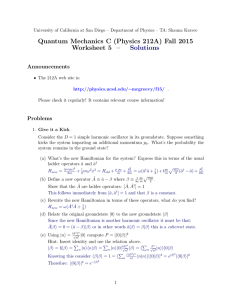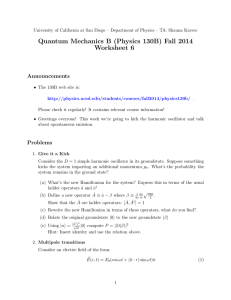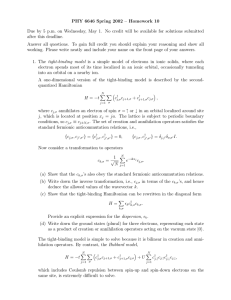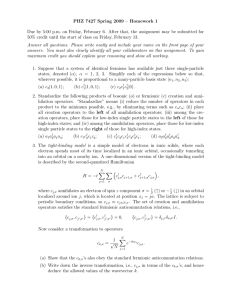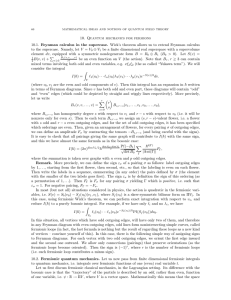Quantum Mechanics C (Physics 212A) Fall 2015 Worksheet 5 Announcements
advertisement
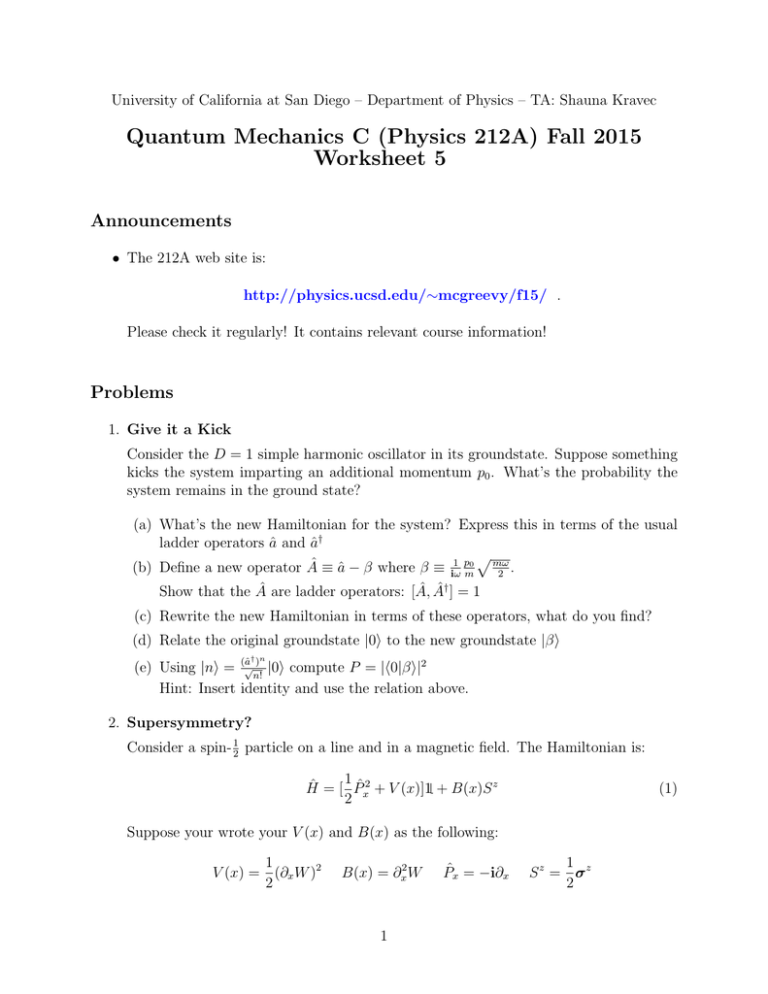
University of California at San Diego – Department of Physics – TA: Shauna Kravec
Quantum Mechanics C (Physics 212A) Fall 2015
Worksheet 5
Announcements
• The 212A web site is:
http://physics.ucsd.edu/∼mcgreevy/f15/ .
Please check it regularly! It contains relevant course information!
Problems
1. Give it a Kick
Consider the D = 1 simple harmonic oscillator in its groundstate. Suppose something
kicks the system imparting an additional momentum p0 . What’s the probability the
system remains in the ground state?
(a) What’s the new Hamiltonian for the system? Express this in terms of the usual
ladder operators â and â†
p
.
(b) Define a new operator  ≡ â − β where β ≡ iω1 pm0 mω
2
Show that the  are ladder operators: [Â, † ] = 1
(c) Rewrite the new Hamiltonian in terms of these operators, what do you find?
(d) Relate the original groundstate |0i to the new groundstate |βi
† n
(e) Using |ni = (â√n!) |0i compute P = |h0|βi|2
Hint: Insert identity and use the relation above.
2. Supersymmetry?
Consider a spin- 21 particle on a line and in a magnetic field. The Hamiltonian is:
1
Ĥ = [ P̂x2 + V (x)]1 + B(x)S z
2
(1)
Suppose your wrote your V (x) and B(x) as the following:
1
V (x) = (∂x W )2
2
B(x) = ∂x2 W
1
P̂x = −i∂x
1
S z = σz
2
Where W (x) is an arbitrary function known as the superpotential. Now define the
following operators:
Q = (P̂x − i∂x W )σ +
Q† = (P̂x + i∂x W )σ −
Where recall σ ± = 21 (σ x ± iσ y ) are raising and lowering operators. Q and Q† are
known as supercharges.
(a) Show that Q2 = 0 = (Q† )2
(b) Show that {Q, Q† } = 2Ĥ where recall {A, B} = AB + BA
(c) Show that [Q, Ĥ] = 0 = [Q† , Ĥ]
(d) We can also define F = σ − σ + which is also a symmetry of (1). Show [F, H] = 0
What are [F, Q] and [F, Q† ] ?
(e) Note that the operators Q, Q† aren’t Hermitian but we can define Q1 = 12 (Q + Q† )
and Q2 = 2i1 (Q − Q† ). What algebra do they satisfy?
Now what does supersymmetry do? Consider an eigenstate |Ψi with energy E.
(f) Compute hΨ|Ĥ|Ψi. What does this tell us about the ground state of the system?
(g) Now also suppose that W (x) → ∞ as x → ±∞. Using
constraint on
the above
Ψ+ (x)
the ground state construct the wavefunction Ψ0 (x) =
in terms of W (x).
Ψ− (x)
Hint: It may be helpful to write:
0
0
0 P̂x − iW 0 (x)
†
Q=
Q =
0
0
P̂x + iW 0 (x) 0
3. Fermions and Bosons
You may already know that SUSY mixes bosons and fermions. How does that appear
in this model? Let’s think about the spin Hilbert space H2 = span{|0i, |1i}
I encourage you to think about these vectors as being labeled by occupation number:
|0i has no fermion (it is bosonic) and |1i has a single fermion.1
The fermionic creation and annihilation operators are then simply: ψ̂ † ≡ σ − ψ̂ ≡ σ +
All states in the Hilbert space can be written as: |Ψi = f0 (x)|0i + f1 (x)ψ̂ † |0i
(a) Convince yourself the above is true and that F = ψ̂ † ψ̂ is a number operator
Now let’s show something non-trivial. I claim that all the excited (E 6= 0) states are
two fold degenerate into bosonic (F = 0) and fermionic (F = 1) pairs.
Let’s do this explicitly:
1
I’m being slick with notation as |0i, |1i are the computer science way of denoting the eigenvectors of σ z
for a spin system.
2
(b) Define |bi to be a state of the form Ψ(x) =
Ψ+ (x)
and |f 0 i ≡ Q† |bi. Show
0
that |f 0 i is fermionic and degenerate with |bi
(c) Show also that the properly normalized states are |f i =
√1 |f 0 i
2E
4. A Certain Magical Index
This model gives another interesting example of an index
It’s going to be useful to define the operator (−1)F , the fermionic parity.
(a) Prove that [(−1)F , H] = 0 = {(−1)F , Q}
And finally the object known as the Witten index
Tr [(−1)F e−βH ]
(2)
The object above is interesting as it only depends on the space of groundstates which
is independent of β and is invariant2 under deforming W (x) → λW (x)
(b) Show that (2) is equal to the number of bosonic groundstates minus the number
of fermionic groundstates.
So for non-zero Witten index there must be some zero modes annihilated by the supercharges. This implies SUSY is not spontaneously broken.
5. The Harmonic Oscillator Redux
Consider W (x) = ω2 x2 in the above problem.
(a) Write the Hamiltonian. What are V (x) and B(x) ?
(b) What’s the groundstate wavefunction? How does it depend on sign[ω]? What’s
the spectrum of the Hamiltonian?
(c) Calculate the Witten index (2) as well as the partition function Z(β) ≡ Tr e−β Ĥ
There’s a lot more to this story, including some very beautiful mathematics, but we’ll
have to pause here without the technology of the path integral.
2
In this sense it is topological.
3
